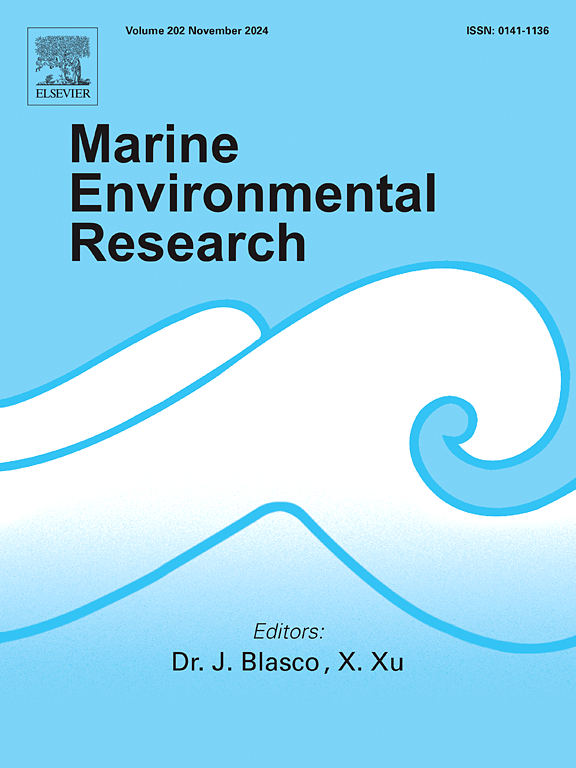Benthic foraminifera as bioindicators of coral condition near mangrove environments
IF 3
3区 环境科学与生态学
Q2 ENVIRONMENTAL SCIENCES
引用次数: 0
Abstract
Climate change stressors such as ocean warming, acidification and deoxygenation are severely threatening coral reefs and the vital ecosystem services they provide. Corals found to survive in mangrove habitats that naturally possess stressful conditions, are being increasingly studied to investigate the impact of multiple co-occurring stressors on coral growth. However, the water quality within mangrove-coral habitats and how this changes with varying distance from the mangroves remains largely unknown. We used the Foraminifera in Reef Assessment and Monitoring Index (FORAM Index) to assess the suitability of environments for coral growth across a mangrove to reef gradient. Sediment samples were collected from five sites at varying proximity to the Low Isles mangroves in the northern Great Barrier Reef. Sites were located: amongst the inner mangroves, the mangrove fringe, the adjacent leeward and windward reef margins and at Opal Reef (control) 38 km away from the mangroves. Foraminiferal community assemblages were used to determine the environmental suitability for coral growth and recovery. The poorest seawater conditions for coral occurred at the inner mangrove site with water quality improving outside the mangroves. Leeward and windward margin sites differed in their suitability for coral growth despite being a similar distance from the mangroves, indicating that water conditions were not necessarily constrained by proximity to mangroves alone. These findings have important implications for studies investigating mangrove-coral habitats as refugia and for assessing linkages between coral reefs and mangroves – two highly threatened tropical ecosystems.

底栖有孔虫作为红树林环境附近珊瑚状况的生物指标
海洋变暖、酸化和脱氧等气候变化压力因素严重威胁着珊瑚礁及其提供的重要生态系统服务。在红树林栖息地中生存的珊瑚自然具有压力条件,越来越多的研究正在调查多种共同发生的压力因素对珊瑚生长的影响。然而,红树林-珊瑚栖息地内的水质以及与红树林的距离如何变化在很大程度上仍然未知。我们使用有孔虫在珊瑚礁评估和监测指数(FORAM指数)来评估红树林到珊瑚礁梯度的珊瑚生长环境的适宜性。沉积物样本是从大堡礁北部低群岛红树林附近的五个地点收集的。地点位于:红树林内部、红树林边缘、邻近的背风和迎风珊瑚礁边缘,以及距离红树林38公里的欧泊礁(对照)。有孔虫群落组合用于确定珊瑚生长和恢复的环境适宜性。红树林内部的海水条件最差,红树林外部的水质则有所改善。背风边缘和迎风边缘地点在珊瑚生长的适宜性方面存在差异,尽管它们与红树林的距离相似,这表明水条件并不一定仅仅受到红树林附近的限制。这些发现对于调查作为避难所的红树林-珊瑚栖息地以及评估珊瑚礁和红树林这两个高度受威胁的热带生态系统之间的联系具有重要意义。
本文章由计算机程序翻译,如有差异,请以英文原文为准。
求助全文
约1分钟内获得全文
求助全文
来源期刊

Marine environmental research
环境科学-毒理学
CiteScore
5.90
自引率
3.00%
发文量
217
审稿时长
46 days
期刊介绍:
Marine Environmental Research publishes original research papers on chemical, physical, and biological interactions in the oceans and coastal waters. The journal serves as a forum for new information on biology, chemistry, and toxicology and syntheses that advance understanding of marine environmental processes.
Submission of multidisciplinary studies is encouraged. Studies that utilize experimental approaches to clarify the roles of anthropogenic and natural causes of changes in marine ecosystems are especially welcome, as are those studies that represent new developments of a theoretical or conceptual aspect of marine science. All papers published in this journal are reviewed by qualified peers prior to acceptance and publication. Examples of topics considered to be appropriate for the journal include, but are not limited to, the following:
– The extent, persistence, and consequences of change and the recovery from such change in natural marine systems
– The biochemical, physiological, and ecological consequences of contaminants to marine organisms and ecosystems
– The biogeochemistry of naturally occurring and anthropogenic substances
– Models that describe and predict the above processes
– Monitoring studies, to the extent that their results provide new information on functional processes
– Methodological papers describing improved quantitative techniques for the marine sciences.
 求助内容:
求助内容: 应助结果提醒方式:
应助结果提醒方式:


